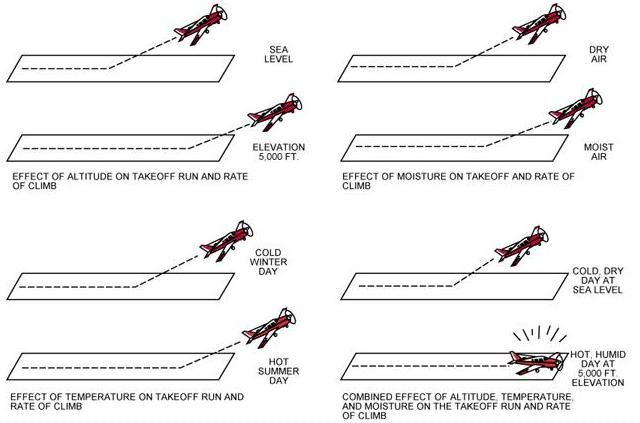
Figure 1-17.—Effect of altitude, temperature, and humidity on takeoff run and rate of climb.
The type of wing design for a particular airplane depends almost entirely on the purpose for which that airplane is to be used. If speed is the prime consideration, a tapered wing is more desirable than a rectangular wing, but a tapered wing with no twist has undesirable stall characteristics. Assuming equal wing area, the tapered wing produces less drag than the rectangular wing because there is less area at the tip of the tapered wing. The elliptical wing is more efficient (greater lift for the amount of drag), but does not have as good stall characteristics as the rectangular wing.
To achieve good stall characteristics, the root of the wing should stall first, with the stall pattern progressing outward to the tip. This type of stall pattern decreases undesirable rolling tendencies and increases lateral control when approaching a stall. It is undesirable that the wingtip stalls first, particularly if the tip of one wing stalls before the tip of the other wing, which usually happens.
A desirable stall pattern can be accomplished by:
• designing the wing with a twist so that the tip has a lower angle
of incidence and therefore a lower angle of attack when the root of the
wing approaches the critical angle of attack;
• designing slots near the leading edge of the wingtip to allow air
to flow smoothly over that part of the wing at higher angles of attack,
therefore allowing the root of the wing to stall first; and
• attaching stall or spoiler strips on the leading edge near the wing
root. This strip breaks up the airflow at higher angles of attack and produces
the desired effect of the root area of the wing stalling first.
Effect of Airspeed on Lift and Drag
An increase in the velocity of the air passing over the wing (airspeed)
increases lift and drag. Lift is increased because:
• the increased impact of the relative wind on the wing’s lower surface
creates a greater amount of air being deflected downward;
• the increased speed of the relative wind over the upper surface creates
a lower pressure on top of the wing (Bernoulli’s Principle); and
• a greater pressure differential between the upper and lower wing
surface is created. Drag is also increased, since any change that increases
lift also increases drag.
Tests show that lift and drag vary as the square of the velocity.
The velocity of the air passing over the wing in flight is determined by
the airspeed of the airplane. This means that if an airplane doubles its
speed, it quadruples the lift and drag (assuming that the angle of attack
remains the same).
Effect of Air Density on Lift and Drag
Lift and drag vary directly with the density of the air. As air
density increases, lift and drag increase and as air density decreases,
lift and drag decrease. Air density is affected by pressure, temperature,
and humidity. At an altitude of 18,000 feet, the density of the air is
half the air density at sea level. Therefore, if an airplane is to maintain
the same lift at high altitudes, the amount of air flowing over the wing
must be the same as at lower altitudes. To do this the speed of the air
over the wings (airspeed) must be increased. This is why an airplane requires
a longer takeoff distance to become airborne at higher altitudes than with
similar conditions at lower altitudes. [Figure 1-17]

Figure 1-17.—Effect of altitude, temperature, and humidity on takeoff run and rate of climb. |
Because air expands when heated, warm air is less dense than cool air. When other conditions remain the same, an airplane will require a longer takeoff run on a hot day than on a cool day.
Effect of altitude, temperature, and humidity on takeoff run and rate of climb.
Because water vapor weighs less than an equal amount of dry air, moist air (high relative humidity) is less dense than dry air (low relative humidity). Therefore, when other conditions remain the same, the airplane will require a longer takeoff run on a humid day than on a dry day. This is especially true on a hot, humid day because the air can hold much more water vapor than on a cool day. The more moisture in the air, the less dense the air. [Figure 1-17]
Less dense air also produces other performance losses beside the loss of lift. Engine horsepower falls off and propeller efficiency decreases because of power loss and propeller blades, being airfoils, are less effective when air is less dense. Since the propeller is not pulling with the force and efficiency it would were the air dense, it takes longer to obtain the necessary forward speed to produce the required lift for takeoff, thus the airplane requires a longer takeoff run. The rate of climb will also be less for the same reasons.
From the preceding discussion, it is obvious that a pilot should be cognizant of the effects of high altitude, hot temperature, and high moisture content (high relative humidity). A combination of these three conditions could be disastrous, especially when combined with a short runway, a heavily loaded airplane, or other takeoff-limiting conditions.